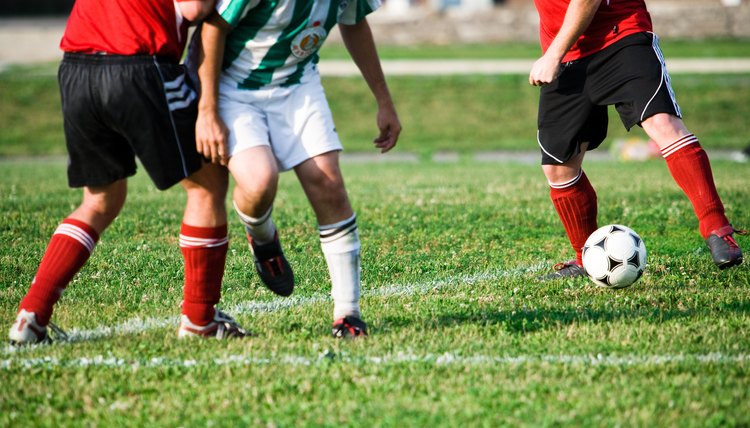Running the Morning Before a Soccer Game

A long, hard jog or run before a soccer game can be detrimental to your performance for a number of reasons. It’s important to take 24 to 48 hours off from exercise to help your body recover and repair itself after intense practices and workouts. Aerobic running also trains different bodily functions than you use during start-and-stop soccer play. To warm up before a soccer game, use moderate-intensity, game-like movements.
Aerobic Running
Long-distance running is aerobic, which means your muscles need oxygen to perform their contractions. You burn more fat during aerobic exercise than when you run sprints, and you engage the slow-twitch fibers in your muscles more than when you sprint. You also don’t train your heart and lungs to recover quickly after an intense soccer game when you do an aerobic run. Save distance running for the offseason.
Light Running
If you want to do some exercise the morning before a soccer game, stick with moderate-intensity running and break it into two-minute intervals. Run in multiple directions, based on what position you play. For example, goalies should include more lateral, or side-to-side running with crossover footwork. Midfielders should run short dashes forward and backward, and forwards should emphasize running forward and on an angle. After each two-minute run, take two minutes to walk while your anaerobic energy system recovers.
Footwork
Another way to run the morning before a soccer game is to practice your footwork. Move your feet quickly using a rope ladder, performing spider drills, jumping in and out of an octagon, running in and out of cones and skipping over hurdles. During regular practices, you’ll perform these types of drills at a very high speed and intensity. The morning before a soccer game, perform these at a moderate intensity so that you don’t stress your body and interfere with the recovery process that’s taking place after your last, intense workout. If you want to run fast, run down a steep hill to generate overspeed. You’ll move your legs at a very high speed, but you're using gravity rather than intense muscular effort. Walk back up the hill slowly after each run.
Plyometrics
Soccer involves jumping, so add plyometric drills to your pre-game warm-up. Take two long strides, then jump as high as you can on the third stride. Do this down the length of the field, then walk back. Repeat this drill starting on the other foot. Practice box jumping, hopping on and off the box from different angles, one foot at a time, then using two feet at once.
Stretching
Don’t perform traditional stretches before you run or play soccer games. When you lengthen a muscle to the point of tension, then hold it for 30 seconds, it can take up to 20 minutes to restore your ability to produce power and maximal vertical leap. Warm up with light jogging, skipping or butt kicks. Save static stretching for after your workouts.
References
Writer Bio
Sam Ashe-Edmunds has been writing and lecturing for decades. He has worked in the corporate and nonprofit arenas as a C-Suite executive, serving on several nonprofit boards. He is an internationally traveled sport science writer and lecturer. He has been published in print publications such as Entrepreneur, Tennis, SI for Kids, Chicago Tribune, Sacramento Bee, and on websites such Smart-Healthy-Living.net, SmartyCents and Youthletic. Edmunds has a bachelor's degree in journalism.
